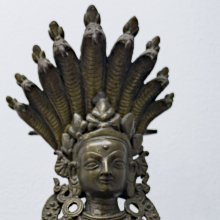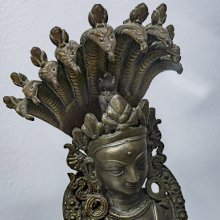Nagakanya, Nāgakanyā, Naga-kanya: 7 definitions
Introduction:
Nagakanya means something in Buddhism, Pali, Hinduism, Sanskrit, Marathi. If you want to know the exact meaning, history, etymology or English translation of this term then check out the descriptions on this page. Add your comment or reference to a book if you want to contribute to this summary article.
Images (photo gallery)
In Hinduism
Purana and Itihasa (epic history)
Source: archive.org: Shiva Purana - English Translation1) Nāgakanyā (नागकन्या) refers to refers to a group of deities according to the Śivapurāṇa 1.24, while explaining the application of Tripuṇḍra to the body:—“[...] or the devotee shall apply the Tripuṇḍra in sixteen parts of the body. [...] or the sixteen parts are:—Head, hair, two eyes, the mouth, two arms, chest, navel, two thighs, knees, two feet and the back. The deities are:—Śiva, Candra, Rudra, ka (Brahmā), Vighneśvara, Viṣṇu, Śrī in the heart, Śambhu, Prajāpati in the navel, Nāga, Nāgakanyās, Ṛṣikanyās in the feet and the ocean of vast expansion in the back. Now the eight parts are mentioned”.
2) Nāgakanyā (नागकन्या) refers to the “Nāga ladies”, according to the Śivapurāṇa 2.2.22. Accordingly as Śiva said to Sitā:—“[...] O my beloved, beautiful woman, clouds will not reach the place where I have to make an abode for you. [...] The daughters of the king of serpents, the mountain damsels, the Nāga ladies (nāgakanyā) and the Turaṅga-Mukhīs will assist you in their excited flutter in congratulating you. Seeing your face of unequalled splendour and beauty and your body of uncommon lustre, the celestial ladies there, despising their own beauty and lacking in interest in their own qualities will begin to stare at you with winkless eyes”.

The Purana (पुराण, purāṇas) refers to Sanskrit literature preserving ancient India’s vast cultural history, including historical legends, religious ceremonies, various arts and sciences. The eighteen mahapuranas total over 400,000 shlokas (metrical couplets) and date to at least several centuries BCE.
Shaktism (Shakta philosophy)
Source: Brill: Śaivism and the Tantric Traditions (shaktism)Nāgakanyā (नागकन्या) refers to “Nāga maidens”, according to Sāhib Kaul’s Śārikāstrotra.—Accordingly, “[...] He who remembers your next syllable, which is īśa with abja, vahni, and padma, is remembered by goddesses in heaven, Nāga maidens (nāgakanyā) in the netherworld, and women on earth confused by the arrows of Kāma. One of pure mind who recites with complete devotion the lakṣmī-syllable, which is difficult for bad people to obtain, him the goddess of good fortune will always be eager to see, and although unsteady (by nature) she will remain at his doorstep out of devotion. [...]”.

Shakta (शाक्त, śākta) or Shaktism (śāktism) represents a tradition of Hinduism where the Goddess (Devi) is revered and worshipped. Shakta literature includes a range of scriptures, including various Agamas and Tantras, although its roots may be traced back to the Vedas.
In Buddhism
Mahayana (major branch of Buddhism)
Source: De Gruyter: A Buddhist Ritual Manual on AgricultureNāgakanyā (नागकन्या) refers to “Nāga girls”, according to the Vajratuṇḍasamayakalparāja, an ancient Buddhist ritual manual on agriculture from the 5th-century (or earlier), containing various instructions for the Sangha to provide agriculture-related services to laypeople including rain-making, weather control and crop protection.—Accordingly, [as the Bhagavān teaches various Nāga-enchantments], “[...] The image of five Nāga girls (nāgakanyā) should be placed in a secret place. Flowers and incense should be offered. It should be kept in a calm place, without having been perceived; nobody should be offered a sight of it. It should be covered with a clean cloth. If there is need, it should be struck with mustard seeds enchanted 108 times. It will accomplish all enterprises. [...]”

Mahayana (महायान, mahāyāna) is a major branch of Buddhism focusing on the path of a Bodhisattva (spiritual aspirants/ enlightened beings). Extant literature is vast and primarely composed in the Sanskrit language. There are many sūtras of which some of the earliest are the various Prajñāpāramitā sūtras.
Languages of India and abroad
Marathi-English dictionary
Source: DDSA: The Molesworth Marathi and English Dictionarynāgakanyā (नागकन्या).—f (S) A fabulous race, or an individual of it, of females of serpentine extraction and very beautiful. 2 fig. A beautiful woman.
Source: DDSA: The Aryabhusan school dictionary, Marathi-Englishnāgakanyā (नागकन्या).—f A fabulous race, or an individual of it, of females of serpentine extraction and very beautiful. A beautiful woman.
Marathi is an Indo-European language having over 70 million native speakers people in (predominantly) Maharashtra India. Marathi, like many other Indo-Aryan languages, evolved from early forms of Prakrit, which itself is a subset of Sanskrit, one of the most ancient languages of the world.
Sanskrit dictionary
Source: DDSA: The practical Sanskrit-English dictionaryNāgakanyā (नागकन्या).—a serpent-virgin.
Nāgakanyā is a Sanskrit compound consisting of the terms nāga and kanyā (कन्या). See also (synonyms): nāgakanyakā.
Source: Cologne Digital Sanskrit Dictionaries: Monier-Williams Sanskrit-English DictionaryNāgakanyā (नागकन्या):—[=nāga-kanyā] [from nāga] ([Kāraṇḍa-vyūha]) f. a serpent-virgin (cf. [Monier-Williams’ Buddhism 220; Religious Thought and Life in India 233]).
Sanskrit, also spelled संस्कृतम् (saṃskṛtam), is an ancient language of India commonly seen as the grandmother of the Indo-European language family (even English!). Closely allied with Prakrit and Pali, Sanskrit is more exhaustive in both grammar and terms and has the most extensive collection of literature in the world, greatly surpassing its sister-languages Greek and Latin.
See also (Relevant definitions)
Starts with: Nagakanyaka.
Full-text: Nakakanni, Nagina, Nagini, Nagakanyaka, Ulupi, Kanya, Rishikanya, Gauri, Iravan.
Relevant text
Search found 12 books and stories containing Nagakanya, Nāgakanyā, Naga-kanya, Nāga-kanyā; (plurals include: Nagakanyas, Nāgakanyās, kanyas, kanyās). You can also click to the full overview containing English textual excerpts. Below are direct links for the most relevant articles:
Garga Samhita (English) (by Danavir Goswami)
Verse 8.13.20 < [Chapter 13 - A Thousand Names of Lord Balarāma]
Shaiva Upanishads (A Critical Study) (by Arpita Chakraborty)
19. Rules relating to the Tripuṇḍra < [Chapter 2 - Greatness of Bhasma and Dhāraṇa]
Sripura (Archaeological Survey) (by Bikash Chandra Pradhan)
Harsadeva Vihara (SRP-4) < [Chapter 2 - The Architectural Panorama]
Puranic encyclopaedia (by Vettam Mani)
The Vishnu Purana (by Horace Hayman Wilson)
Jainism in Odisha (Orissa) (by Ashis Ranjan Sahoo)
The Jaina Temple of Choudhury Bazar, Cuttack City < [Chapter 3: Survey of Jaina Antiquities in Odisha]
Secular and Religious Figurines and Motifs in Jain Art < [Chapter 5]

